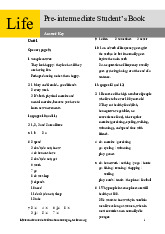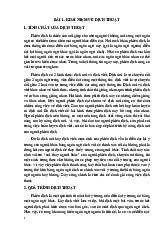





Preview text:
LESSON PLAN
TIẾNG ANH 11 FRIENDS GLOBAL
UNIT 3: SUSTAINABLE HEALTH
LESSON 3C- LISTENING: THE BODY’S LIMITS I. OBJECTIVES
By the end of this lesson, Ss will be able to: 1. Knowledge
- Gain some trivial knowledge about the limits of human survival.
- Gain vocabulary about large numbers, fractions, percentages, ratios, etc.
- Gain vocabulary about the body’s limits.
- Know the stress pattern of a sentence. 2. Competences
- Describe pictures about extreme activities.
- Note down numbers when listening to an article about the limits of human survival.
- Understand details of an interview about the limits of human survival.
- Talk about extreme conditions they have encountered.
- Develop self-study skills, collaborative skills and creativity. 3. Personal qualities
- Build an awareness of keeping the body in good conditions.
- Be collaborative and supportive in pair work and teamwork.
- Actively join in class activities. II. MATERIALS
- Grade 11 textbook, Unit 3, Listening audios
- Computer connected to the Internet - Projector / TV - PowePoint Unit 3C III. PROCEDURES
1. ACTIVITY 1: WARM-UP (3 mins) a. Objectives:
- Introduce the new lesson and set the scene for Ss to acquire new language.
- Get students' attention at the beginning of the class.
- Activate students’ background knowledge.
- Students can gain more confidence and interest in the lesson. b. Content:
- Activity: A picture says a thousand words - Exercise 1. (p.39) c. Products:
- Students discuss with their friends and create a story based on the prompt. d. Organisation
TEACHER’S AND STUDENTS’ ACTIVITIES CONTENTS
A picture says a thousand words / Exercise 1: Work in pairs. Look at the photo. What do you
think this app does? Why might some people need it? (5 mins)
Teacher can choose between the 2 activities to help the Ss engage in the lesson.
A picture says a thousand words:
- T goes through the instruction: Students work in
groups. Each group looks at 2 pictures and write 5 Wh-
questions for each of the pictures in 2 minutes:
What…? Where…? When…? Why…? How…?
- T can elicit some questions as examples first before discussion.
- Then the groups exchange their sets of questions and
answer them to create a short story through speaking.
Which group has the most interesting story is the winner.
- T and other groups listen and give feedback.
Exercise 1: (Use this activity instead if T wants to save
Suggested Answers for Exercise 1: time)
Both show people doing physically
- T focuses Ss’ attention on the photos. Ask: What sort
challenging activities in extreme conditions.
of weather conditions are the people in? What sort of
In photo A, the people are walking in a activities are they doing?
desert in extreme heat. They are lightly - Elicit some answers.
dressed and carrying rucksacks. If they
- Students then discuss the questions in pairs.
aren’t careful, they could become
- A few students share their ideas with the class.
dehydrated and even die. In photo B, there is
a climber sitting outside a tent in the
mountains. He’s wearing an oxygen mask to
help him breathe at this high altitude. e. Assessment
- Teacher observes the groups and give feedback.
2. ACTIVITY 2: PRE-LISTENING (20 mins) a. Objectives:
- Ss gain vocabulary about large numbers, fractions, percentages, ratios, etc.
- Ss gain vocabulary about the body’s limits.
- Ss can use a listening strategy to identify numbers in a listening b. Content: - Exercise 2 (p.39) - Exercise 3 (p.39)
- Pre-teach vocabulary related to the topic. c. Products:
- Ss take notes the numbers in their books/notebooks.
- Ss pronounce the new words correctly and use them in appropriate contexts. d. Organisation
TEACHER’S AND STUDENTS’ ACTIVITIES CONTENT
Exercise 2: Read the Listening Strategy. Then try to say the numbers and measurements below. Listen and check. (5 mins)
- T goes through the Listening Strategy.
- Students practise saying the numbers in pairs.
- T asks individual students to say the numbers.
- T plays the recording for students to listen, check and repeat. - T also points out:
• When we say numbers with decimals, we use point, e.g. 3.5 is three point five.
• When we say years, we treat the first two digits as a
separate number, e.g. 2015 is twenty fifteen
• When we say ratios, we use to, e.g. 20:2 is twenty to two.
• When we talk about a range, we can say between …
and … or … to … Therefore, 5–10 is five to ten or between five and ten.
• Zero can be pronounced as nought/naught /nɔːt/ Extra activity
- T asks students to write down one large number, one
small number with a decimal, one year, one fraction, one
percentage, one ratio and one temperature in numerical
form. They must not show the numbers to anyone.
- In pairs, students take turns to read out their numbers.
Their partners must write down what they hear in
numerical form. Do the numbers match?
Exercise 3: Read and listen to the article. Complete the article with numbers and measurements from exercise 2. (5 mins)
- T asks students to read the article, then plays the Answers:
recording for students to complete it.
1 –40°c 2 5°c 3 15°c 4 50%
- T checks answers as a class.
5 57% 6 4,500 7 1/5 8 1/10
Pre-teach vocabulary related to the topic (10 mins)
- T goes through the slides and elicits the words from 1. limit /ˈlɪmɪt/ (n.) the pictures first.
2. dehydrated /ˌdiːhaɪˈdreɪtɪd/ (adj.)
- T conducts oral drill chorally and individually.
3. extreme /ɪkˈstriːm/ (n.)
- T asks CCQs to check Ss’ understanding. 4. collapse /kəˈlæps/ (v.)
- Ss answer and take notes of new vocabulary.
5. deliberate /dɪˈlɪbərət/ (adj.)
- Ss work in pairs to complete the matching exercise on
6. fragile /ˈfrædʒaɪl/ /ˈfrædʒl/ (adj.)
the slide to learn more vocab for the listening Answer:
-T goes through the slides again to check pronunciation. e. Assessment
- Teacher checks students’ pronunciation and gives feedback.
- Teacher checks students’ understanding of listening strategy.
- Teacher observes Ss’ writing of vocabulary on their notebooks.
3. ACTIVITY 2: WHILE-LISTENING (15 mins) a. Objectives:
- Ss can understand the details of an interview about the limits of human survival. b. Content: - Exercise 4. (p.39) - Exercise 5. (p.39) c. Products:
- Students listen attentively and complete exercises in their books. d. Organisation
TEACHER’S AND STUDENTS’ ACTIVITIES CONTENTS
Exercise 4: Listen to an interview with a scientist. Which of the people he talks about tested the
body’s limits deliberately? (5 mins)
- T goes through the instructions. Answer:
- T plays the recording for students to answer the Randy Gardner question. Script:
- Ss volunteer to answer the questions and report
“… For example, on 28 December 1963, Randy what they have heard
Gardner, a 17-year-old student, got up at 6 o’clock
in the morning and didn’t go back to sleep again
until the morning of 8 January 1964…”
Exercise 5: Read the sentences aloud, paying attention to the numbers. Then listen again and
decide whether the sentences are true or false. Write T or F and correct the false sentences. (10 mins)
- Students read the sentences aloud in pairs. Answer key:
- T play the recording again for students to mark
1 F they died after 30–40 seconds.
the sentences as true or false and correct the false 2 T sentences.
3 F the pressure dropped to almost zero for 27
- Ss check their answers with their friends. seconds.
- T invites some students to write their answers on 4 T the board.
5 F He slept for almost 15 hours.
- T plays the recording again and focuses on the evidence in the recording. e. Assessment
- Teacher observation on Ss’ performance.
- Teacher’s feedback and peers’ feedback.
4. ACTIVITY 3: POST-LISTENING (10 mins) a. Objectives:
- Know the stress pattern of a sentence.
- Talk about extreme conditions they have encountered. b. Content: - Exercise 6 (p.39) - Exercise 7 (p.39) c. Products:
- Students pronounce correctly the stress of a sentence.
- Ss discuss their experiences with extreme conditions. d. Organisation
TEACHER’S AND STUDENTS’ ACTIVITIES CONTENTS
Exercise 6: Listen and mark the words that are stressed in the sentences from exercise 5. Then
practise saying the sentences yourself. (5 mins)
- T plays the recording for students to mark the words
1. When a Russian space CAPSULE had a
that are stressed in the sentences from exercise 5.
major PROBLEM in 1971, the cosmonauts
- T reminds students that only content words carrying
died in less than 30 seconds.
the meaning are stressed and that structure words such
2. In 1966, a SCIENTIST PASSED out after
as pronouns, prepositions, articles, conjunctions and
15 seconds in a VACUUM.
auxiliary verbs are unstressed.
3. The SCIENTIST PASSED out for 27
- Students work in pairs to practise saying the sentences. SECONDS.
4. In the 1960s, Randy Gardner STAYED
awake for more than 250 HOURS.
5. After STAYING awake for so long, randy
Gardner then SLEPT for almost 50 HOURS.
Exercise 7: Discuss the questions in pairs. (5 mins)
- T asks students: What does it feel like not to be
1 Have you ever been awake all night or
allowed to sleep? Elicit a few answers.
most of the night? If so, when / where /
- In pairs, students discuss the questions. why?
- A few students volunteer to share their ideas with the
2 Have you ever felt very cold? If so, when / class. where / why?
3 Have you ever experienced high altitude?
If so, when / where / why? How did you feel? e. Assessment
- Teacher observation on Ss’ performance.
- Teacher’s feedback and peers’ feedback. 5. CONSOLIDATION (3 mins) a. Wrap-up
- If T is using the Classroom Presentation Tool, first do the lesson closer to review what has been covered in this lesson.
- T asks students: What have you learned today? What can you do now? and elicits answers: I
can listen for specific information, particularly numbers, dates and measurements. I can
describe my experience of enduring difficult situations. b. Homework
- Prepare for the next lesson




